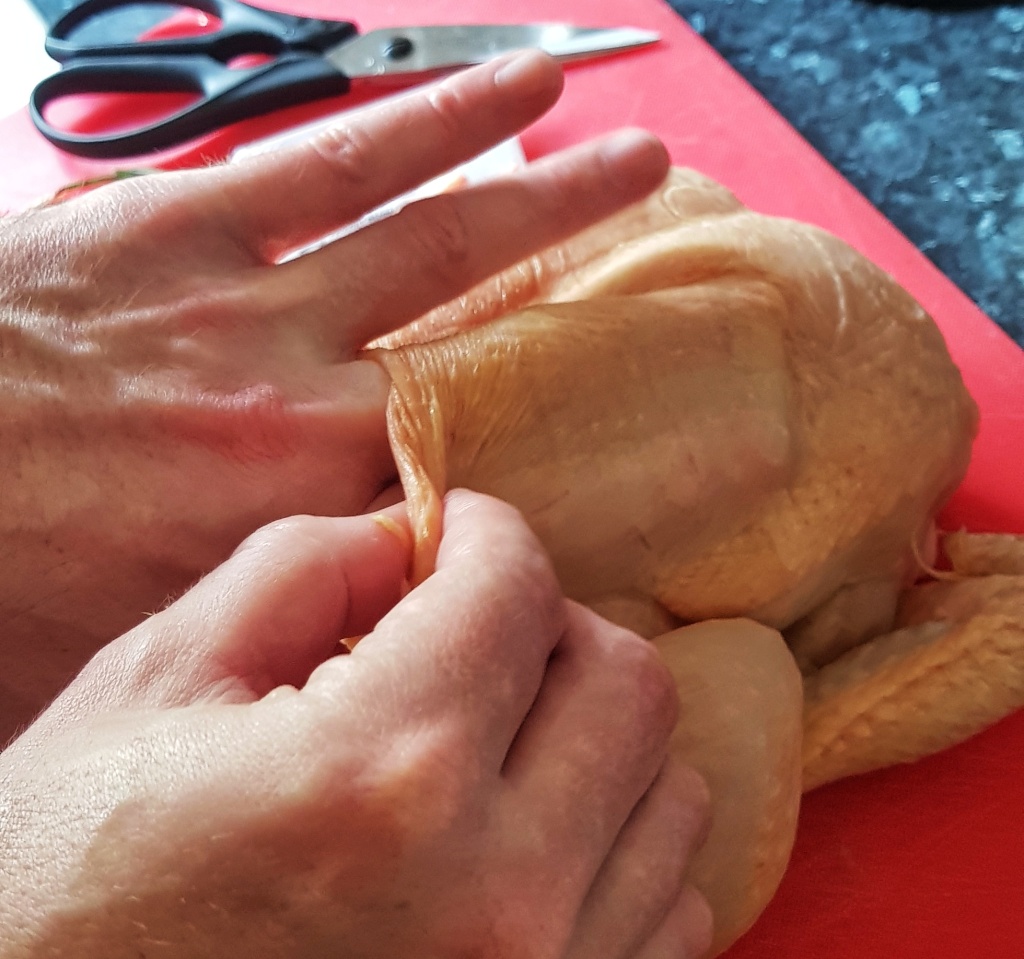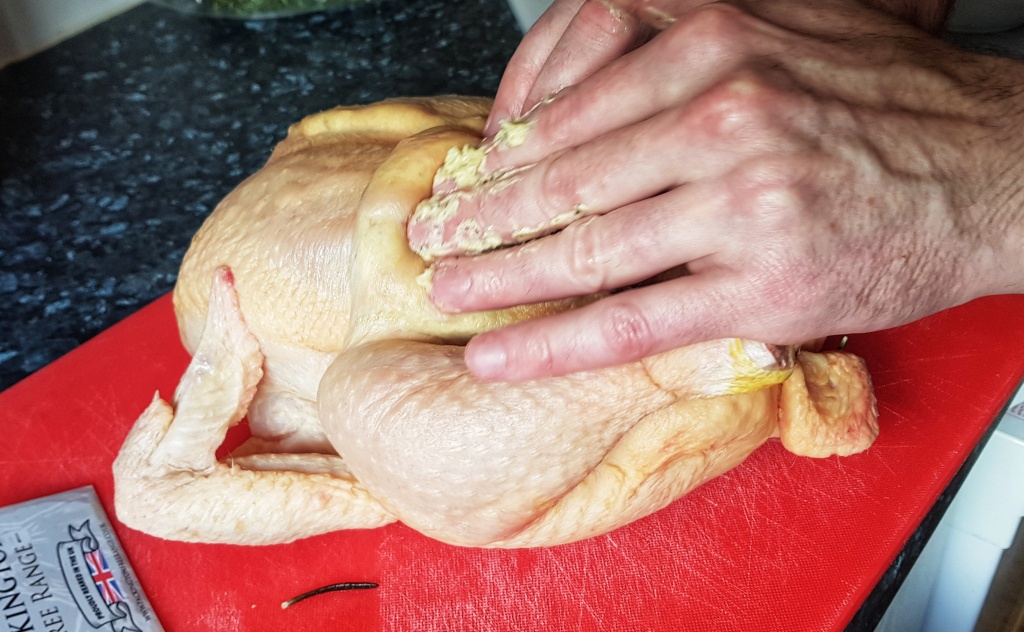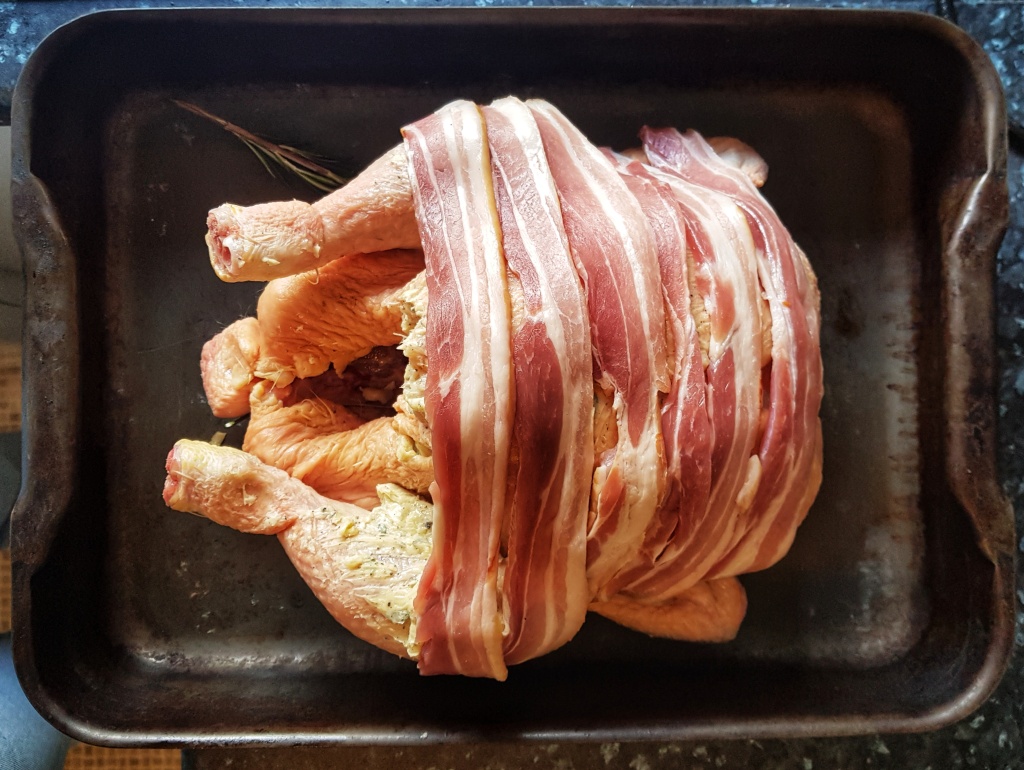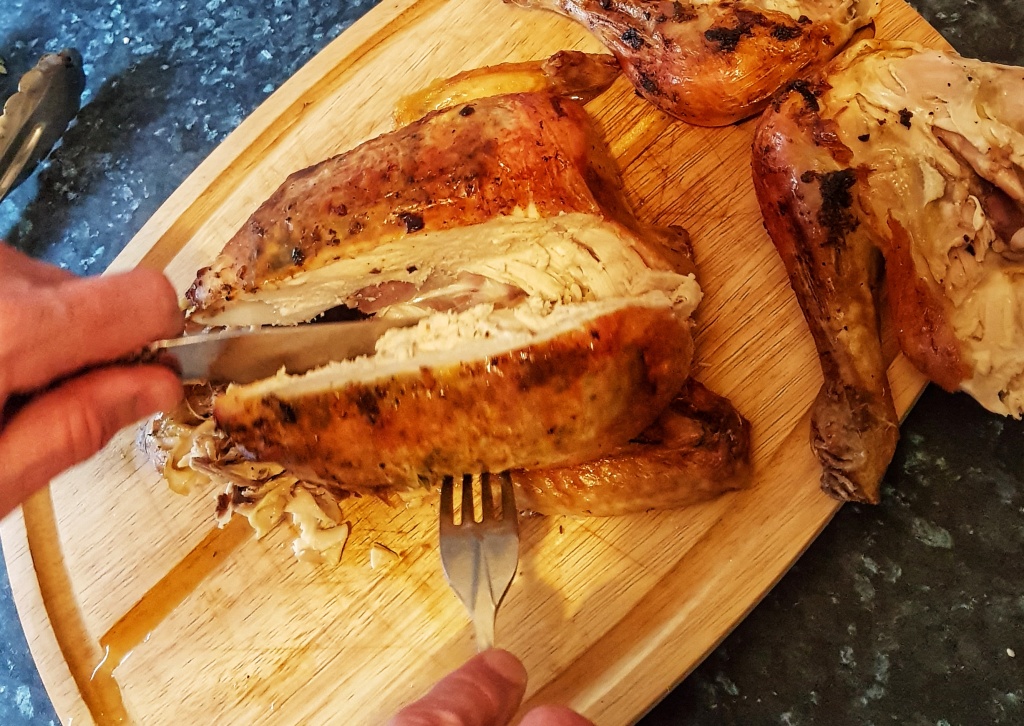
For centuries, the British were famous for their roast meat, attached to a spit before being hand-turned by some poor soul in front of a devilishly hot fire. We no longer do this, today we cook them in the oven, so technically they are baked meats not roasted ones. Searching for historical recipes for roast chicken is rather tricky: they were rarely roasted – they were a dependable source of eggs after all – so only chickens that stopped laying were eaten, those so-called ‘old boilers’. Instead, capons provided tender meat; these castrated cockerels were put to good, being otherwise surplus to requirement. Unfortunately, in today’s mass production of eggs, male chicks are killed as soon as they can be sexed.
When you do find a recipe, there is little focus on the roasting itself. Check out this recipe for ‘Chicken Endored’ from around 1450:
Take a chicken, draw it and roast it; let the feet be on and take away the head. Then make a batter of egg yolks and flour, and add to it ground ginger and pepper, saffron and salt, and spread it over until it is roasted enough.

By the eighteenth century, there is little more instruction, but we do at least get a cooking time:
To roast young chickens, pluck them very carefully, draw them, only cut off the claws, truss them, and put them down to a good fire. Singe, dust and baste them with butter, they will take a quarter of an hour roasting. Then…lay them on your dish.
We can only assume that the roasting part of the process was already in the readers’ skill set.
My recipe is below, but there are a few things I should mention first: First, never wash your chicken! It’s unhygienic and it will stop the skin crisping up. Second, do not overcook and don’t fear the salmonella; follow the times and temperatures precisely and you will be grand. Thirdly, use plenty of butter and bacon to season the bird and keep moist. I make a flavoured butter for the roasting, but using just butter will still produce great results.
If you like the blogs and podcast I produce, please consider treating me to a virtual coffee or pint, or even a £3 monthly subscription: follow this link for more information.
1 free-range chicken
100 g butter, softened
Salt and pepper
Any flavourings you like: e.g. 1 to 4 finely chopped cloves of garlic, 1 tsp chopped thyme or lemon thyme, truffle trimmings, chopped rosemary, grated zest half a lemon, chopped olives, anchovies or capers, ½ tsp smoked paprika. The list really is endless.
8 rashers of dry cured bacon, smoked or unsmoked
100 ml white wine
300 ml chicken stock
1 tbs cornflour
Remove the chicken from the fridge and hour before you want to roast it. Untruss it and preheat the oven to 190°C.
Mash the butter with the salt and pepper using a fork and stir in the flavouring ingredients, if using. Set aside.
Sit the chicken on a board, untruss it and turn it so that the cavity is facing you and carefully lift the skin away from the breasts. The technique is to insert the tips of your middle three fingers gingerly underneath the skin lifting it away from one breast, using your other hand to keep the skin taught, lest it tears. Repeat for the other breast

Next, place the flavoured butter under the skin, massaging it so to evenly distribute it over the breasts.

Make sure there is plenty under there, but reserve around a quarter of it to spread it over the legs. Next, lay the rashers of bacon over the bird so they overlap only slightly.
Weigh the chicken then pop it on a roasting tin. Don’t be tempted to truss it. Calculate the cooking time: 45 minutes per kilo plus 15 minutes and place in the oven.

Leave undisturbed for 30 minutes, and then baste with any butter that has melted and leaked from the bird. Tip to one side, so that buttery juices come out of the chicken. Baste with the juices every 20 minutes or so, and when the bacon is sufficiently crisp, remove it and let the bird roast without its porky jacket for the remaining time.
Remove and check its cooked all of the way through by easing the leg away from the body, it should be filled with delicious, clear juices. If unsure, use a sharp knife to test the juices are clear in thickest part of the leg. If they are tinged with pink, roast ten more minutes.
Remove the tender chicken – be careful it may start to collapse a bit, so be swift and use a fish slice and a pair of tongs to help you guide it to a board safely and all in one piece. Cover with foil to rest while you make the gravy.
Tip the juices into a jug and allow to settle for a few minutes. Place the roasting tin over a medium-high heat and brown any delicious detritus that remains in the roasting tin. Deglaze with the wine, scraping off any brown bits with a wooden spoon, then tip the whole lot into a saucepan and bring to a simmer. Meanwhile skim away most of the fat from the chicken juices and pour them into the pan along with the stock. Bring to a boil and let it bubble away for ten minutes so it reduces a little.
Now slake the cornflour with a few tablespoons of cold water and whisk it briskly into the gravy. Give it a couple of minutes to thicken, and if it seems on the thin side, slake a little more; it’s all down to preference, I prefer a thin gravy.
Check for seasoning and leave on a low heat whilst you get everything ready.

To carve the chicken I find it easiest to remove the legs first, cutting them at the knee to give two thighs and two drumsticks, and then cutting each breast away in one piece, cutting them into four or five thick pieces.

Arrange them on a warmed serving plate and don’t forget to serve the bacon.

References
The Culinary Recipes of Medieval England (2013) compiled and translated by Constance B Hieatt
The Experienced English Housekeeper (1769) Elizabeth Raffald

I’ve always wondered about that 15 minutes roasting time. I know chickens were a lot smaller but……..
And how right you are about the dry curing of the bacon – absolutely essential that it isn’t the wet cured kind, which sticks to the skin and pulls it away when you take the bacon off.
Just looking at your previous chicken recipes I am reminded that I need to sow more turnips so I have them when the quinces are ripe – I’ve never tried that particular recipe
LikeLiked by 1 person
Oh yes, that’s a great recipe!
LikeLike
Thanks for this mouth-watering recipe. I can’t wait to cook it. All the best from the sweltering East Coast of the US.
LikeLiked by 1 person
let me know how you get on! Thanks – from the sweltering heat of northern England!
LikeLike
Neil, that looks perfect! Just that and a pile of buttery mashed potatoes, and I would be very happy indeed.
LikeLiked by 1 person
Which reminds me to do a post on mash!
LikeLike
“For centuries, the British were famous for its roast meat.”
You insult the British with that sort of grammar. I’ll wager your food is just as bad
LikeLiked by 1 person
Thank you so much for pointing my grammatical error, and for doing it so nicely. I hope the British aren’t too insulted.
And if grammar is positively correlated with cooking skills, as you hypothesise, your food must be delicious! I wish I was more like you.
Lots of love,
Neil x
LikeLiked by 1 person
Pingback: Happy New Year! | British Food: A History
Pingback: #442 Smoked Chicken with Three-Melon Salad – Neil Cooks Grigson